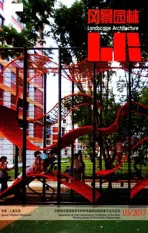超越游乐场:专访荷兰卡韦事务所创始人埃尔赫·比利茨先生
2017-06-22张博雅
超越游乐场:专访荷兰卡韦事务所创始人埃尔赫·比利茨先生
More Than Playgrounds: Interview with Elger Blitz, Carve Landscape Architecture
Carve Landscape Architecture(荷兰卡韦事务所,以下简称“Carve”)成立于1997年,近二十年来,Carve一直专注于以儿童、青年为中心的公共空间设计,致力于提供具有无限游戏可能的空间及装置设计。Carve 的作品主要集中在荷兰及欧洲大陆,这些作品曾经被世界各地的媒体报道。Carve 认为,设计游戏绝不仅限于设计“游乐场”,而是一种激活城市的手段。本刊记者对Carve创始人埃尔赫·比利茨(Elger Blitz)先生进行了专访,详细探讨了他们的工作方法。采访/整理:张博雅,荷兰代尔夫特理工大学风景园林硕士
Carve, founded in 1997, has been working on playing space for 20 years. According to their design philosophy, designing play is not only making playgrounds. Moreover, it’s a way to activate urban space. Our journalist interviewed the co-founder of Carve, Mr. Blitz, on the way they work for playgrounds. Interview and Summarize: Boya Zhang, MSc Landscape Architecture, TU Delft
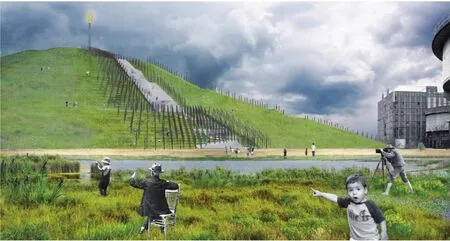
1 矿山游乐场投标设计The bid design
LAJ: Landscape Architecture JournalElger: Elger Blitz
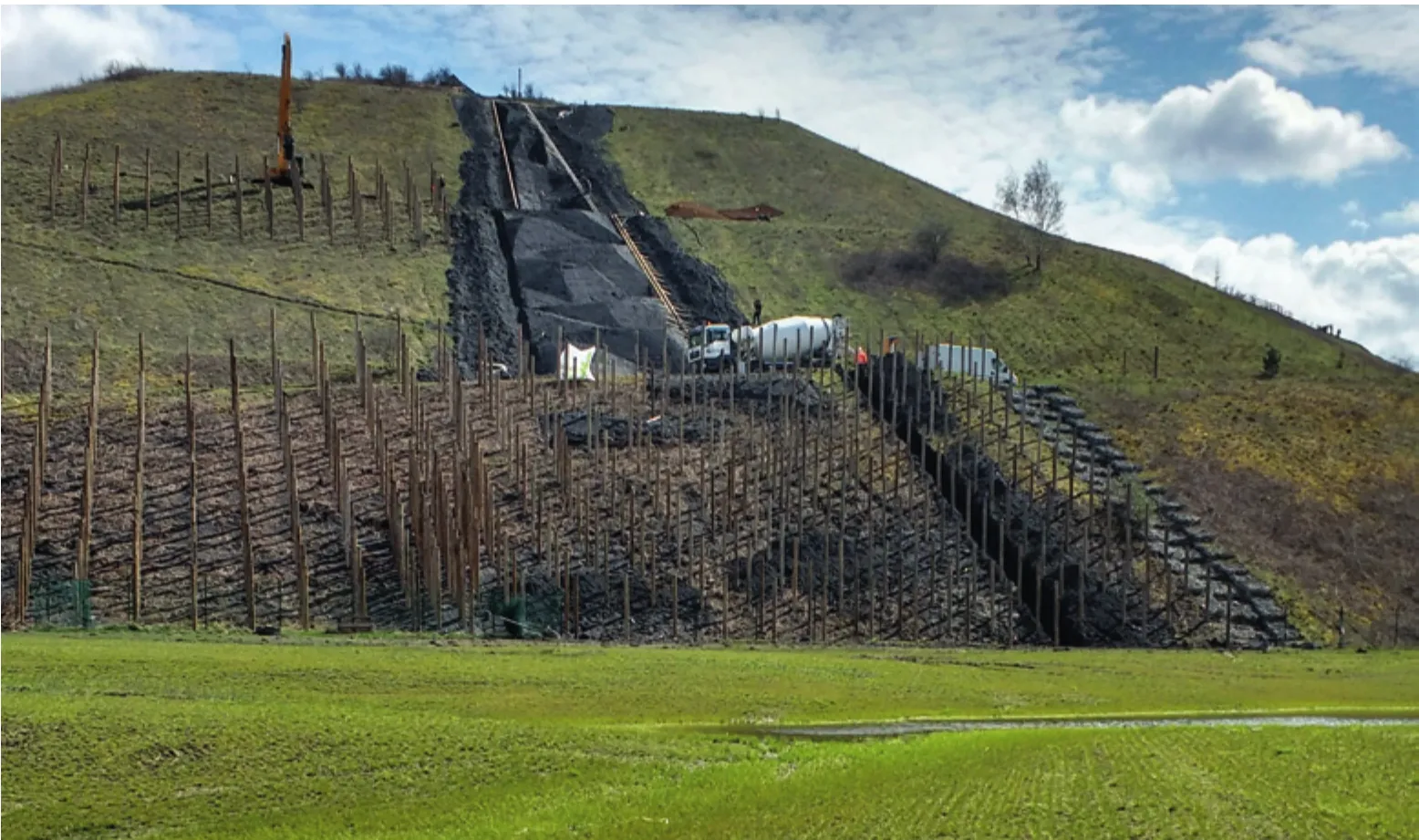
2 矿山游乐场施工过程The construction process
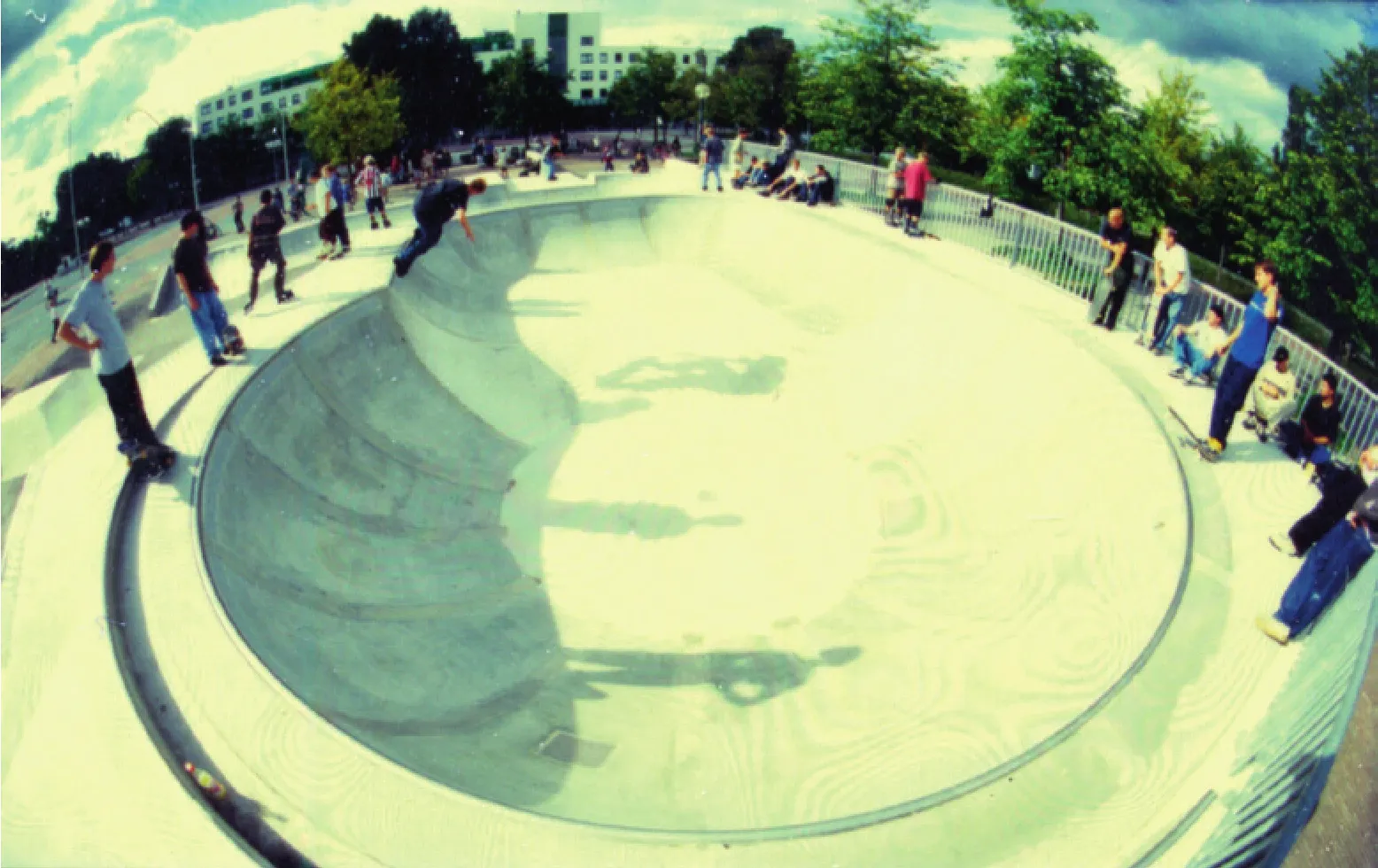
3 Carve的第一个项目,位于荷兰Hoofddrop的滑板公园The first project of Carve, the Hoofddrop skate park, Netherlands
LAJ:能否向我们介绍一下您最近的项目?
Elger:我们最近的项目之一是位于比利时的矿山游乐场(Be-Mine)。这里曾经是一座煤矿,通往65m高的煤渣山山顶的趣味坡道是项目的重要组成部分。
我们的方案利用了山体原始形态,将其转化成为用于玩耍的坡面。设计的灵感来源于当年矿工身上的吃苦精神和同志情谊。上山的方式很多,你可以和朋友们协作登上山顶,也可以自己来(图1、2)。
这个项目和比利时当地的奥黑明事务所(Omgeving)以及施工方科林克思工程公司(Krinkels)共同完成。由于坡顶高度超过了60m,项目过程中有很多关于儿童安全的担心和讨论。幸运的是,经过第三方安全鉴定机构的评估,我们的所有装置,包括超长滑梯,都符合安全标准。
LAJ:Carve已经成立近20年了。您当时是如何开始从事游戏空间设计的呢?
Elger:非常偶然。我曾经学习建筑,也从20世纪80年代初(上中学的时候)开始玩滑板。那时候没有多少公共的滑板公园,因此我们开始设计和建造自己的滑板公园。90年代初,我协助一家游乐场制造商成功地设计和制造了滑板设施,于是他们邀请我为他们工作,设计游乐场装置以及街道家具(图3)。
在这份工作中,我越来越关注在城市视角下看待“玩”,而不是让游戏装置成为孤立的存在。为了实践我的想法,我必须成立我自己的工作室。
LAJ:您当时对什么不满意呢?
Elger:90年代中期,游乐场或多或少都是从标准目录上选出来的松散的产品组合。我对几方面不太满意,比如,你几乎没法在这些游乐场体验到你小时候你家附近无名空地的魔力。另外,我也对装置本身的设计感到失望。为什么不能像建筑师设计房子那样设计独一无二的、与所处环境密切联系的游乐场呢?我对把建筑的品质赋予游乐场的想法感到着迷。
LAJ:“建筑的品质”具体指什么呢?
Elger:我是指好设计具有的附加值,或者通常意义上的好建筑。在建筑师看来,没有什么比建造商产品目录上的“标准公寓”更加糟糕的东西了。对游乐场来说,这难道不一样吗?为什么我们不能针对具体的场地特征和用户需求,做能突出场地特色的游乐场设计,而不是仅仅在红色钢制秋千或者蓝色钢制秋千中做选择?我发现,在今天,在阿姆斯特丹、纽约或是北京的游乐场看起来差不多并不是什么新鲜事。它们来自同一家北欧供应商。如果游乐场不是为了其所处环境而建造,那你甚至没法(通过它)分辨这到底是哪儿。通过孩子的视角想想吧,(如果告诉你的小伙伴)“让我们在那个有塑料滑梯的游乐场见”,那有可能是任何地方。还是你宁愿说,“让我们在‘蓝色小山广场’见”呢?这关乎“场所”的意义(图4~6)。
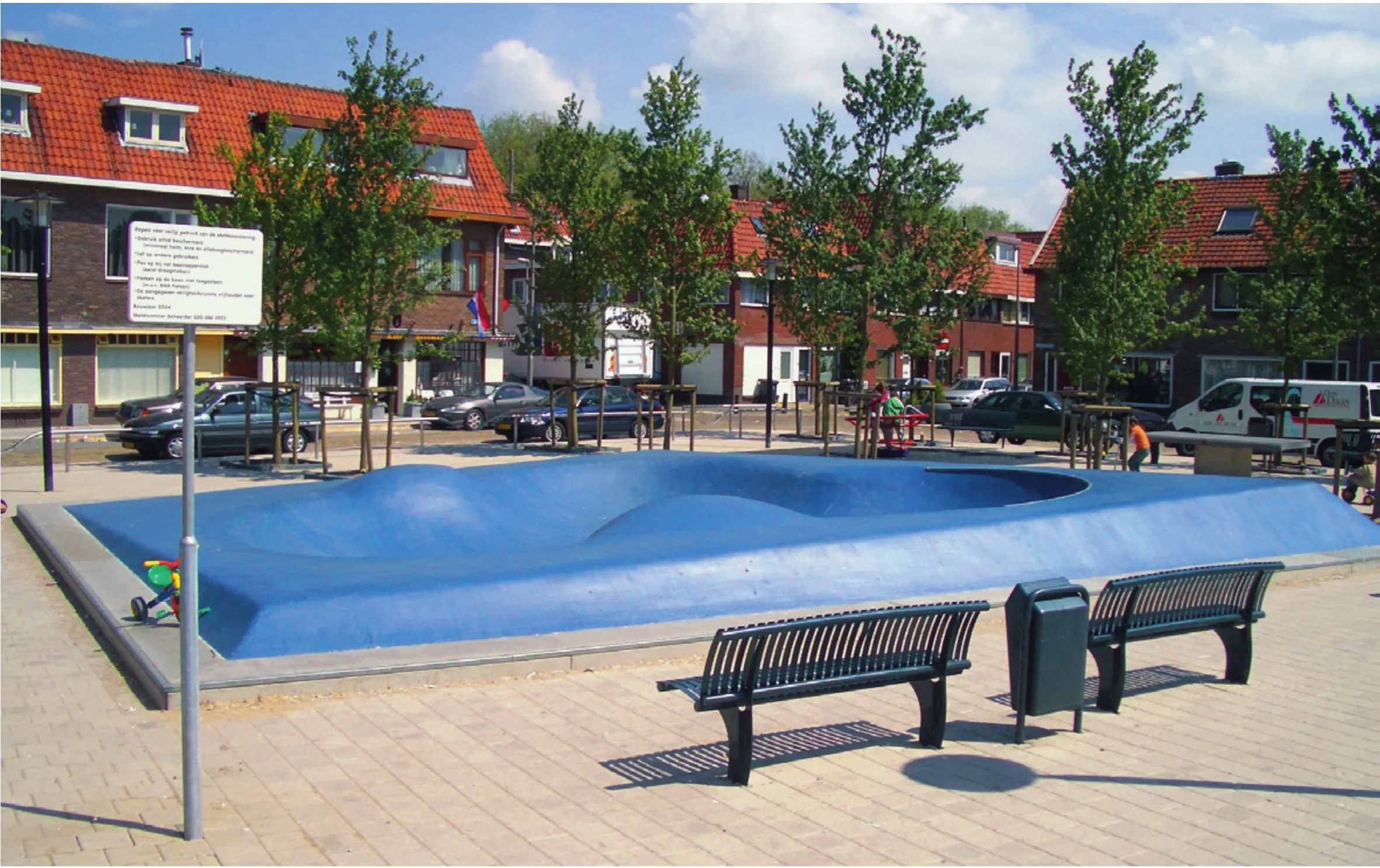
4 Carve 作品:Bischopsplein,荷兰乌特勒支Carve,s project , Bischopsplein, Utrecht, Netherlands
LAJ:Carve的每一个作品都是独一无二的。这种独特会意味着造价高昂吗?
Elger:我没资格来断定我们的所有设计都是独一无二的,不过我们尽力了。至于造价,可能会让你吃惊的是,这些特别设计的游乐场通常不比那些“货架上的”游乐场更贵。制造商、批发商、代理商等,他们都想从中获利。你可以(把游乐场)与任何消费品进行比较。由于供应链的存在,消费品从生产到零售可能会涨价3到4倍。生产一双零售价100美元的品牌运动鞋只需要25美元!此外,得益于现代化的技术,比如3D打印和切割,生产特别定制的东西越来越便宜和容易了。我们经常使用这些技术。如果把我们的工作方式与在产品目录上挑选作比较,我能想到的我们的唯一缺点是设计过程需要时间。当然,我们的最终成果一定能值回那些时间。
LAJ:Carve的很多作品都非常多彩。您对颜色有什么特别的考虑吗?
Elger:对我来说,颜色不如设计中的其他要素重要,它们通常只是提醒成年人,“看,这是个游乐场”。我们曾经做过全黑的游乐场(图7、8),对孩子来说,它们和那些五颜六色的游乐场一样有魅力。更有趣的是,孩子们把这里当成了黑板,这是我们从来没想到的。这也是关于孩子们“自己”的游乐场的很好例注。
当然了,我们也设计过相当鲜艳的游乐场。比如在拜尔莫公园(Bijlmer)的游乐场的设计中,当我们参加了几次社区公众参与会议后,我们把颜色作为头等大事来看待。这里的居民有着不同的族裔背景,在他们各自的文化中都有对明亮颜色的偏好,颜色可以成为他们的纽带(图9、10)。
另一个例子是我们在范伯宁广场 (Van Beuningenplein)中使用的蓝色。紧邻广场的房子是19世纪著名建筑师卡雷尔·巴泽 (K.P.C Bazel)为数不多的社会福利住房设计,同时,巴泽也以其蓝色压制玻璃器皿而闻名。总的来说,颜色的选择很随机,根据项目具体情况来,没有一定之规(图11、12)。
LAJ:的确如此。Aldo van Eyck 的游乐场就几乎没有颜色(图13)。(Aldo van Eyck,阿尔多·范·艾克,荷兰战后重建时期建筑大师,在战后百废待兴的阿姆斯特丹设计了一系列低成本的以游乐设施为中心的公共空间)
Elger:是的,这也说明了游戏和颜色没有必然联系。人们常常谈及阿尔多的700多个游乐场设计,不过对我来说阿尔多的作品的意义在于其社会价值。
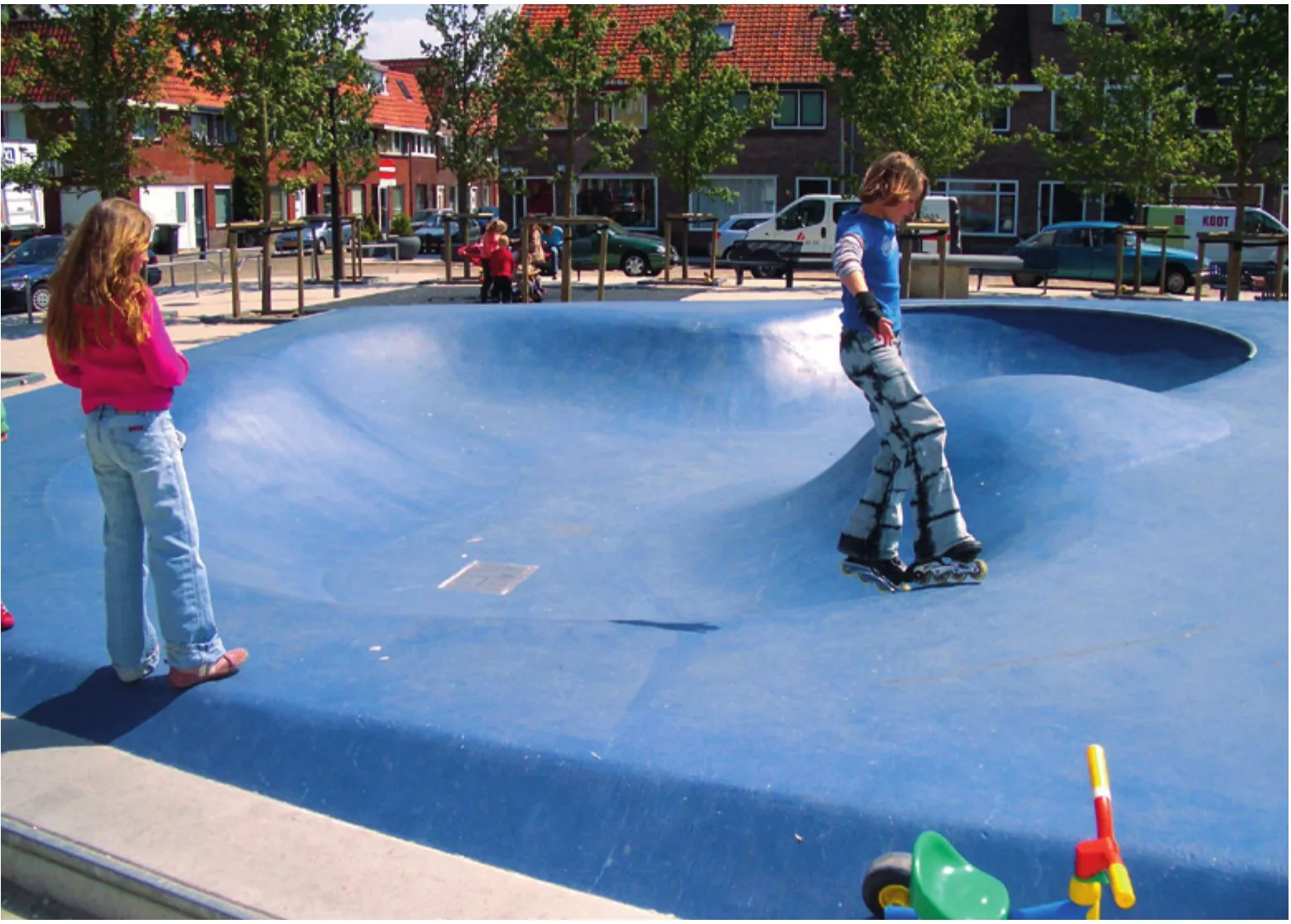
5 Carve 作品:Bischopsplein,荷兰乌特勒支Carve,s project , Bischopsplein,Utrecht, Netherlands
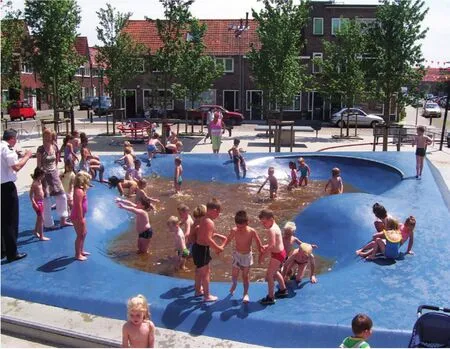
6 Carve 作品:Bischopsplein,荷兰乌特勒支Carve,s project , Bischopsplein,Utrecht, Netherlands
战后,凡·伊斯特恩(Van Eesteren)起草的阿姆斯特丹规划明显缺乏对于人尺度的关注,更不要说儿童尺度了。阿尔多和雅各布·穆德 ( Jacoba Mulder)“软化”了这份规划。他们设计了 L 型的街区,创造了围合的庭院空间。这些空间对公众开放,并禁止车辆通行。阿尔多在这些空间里安置了简单的游戏装置,它们首先吸引了孩子们,家长随后而至。这是精心的设计促进社会联系的策略。
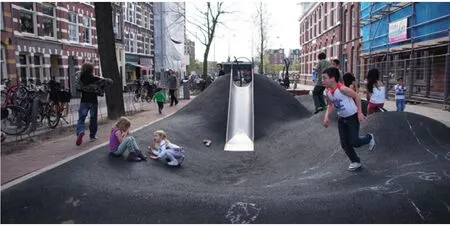
7 Carve 作品:Potgieter 街,荷兰阿姆斯特丹Carve's project , Potgieter,Amsterdam, Netherlands
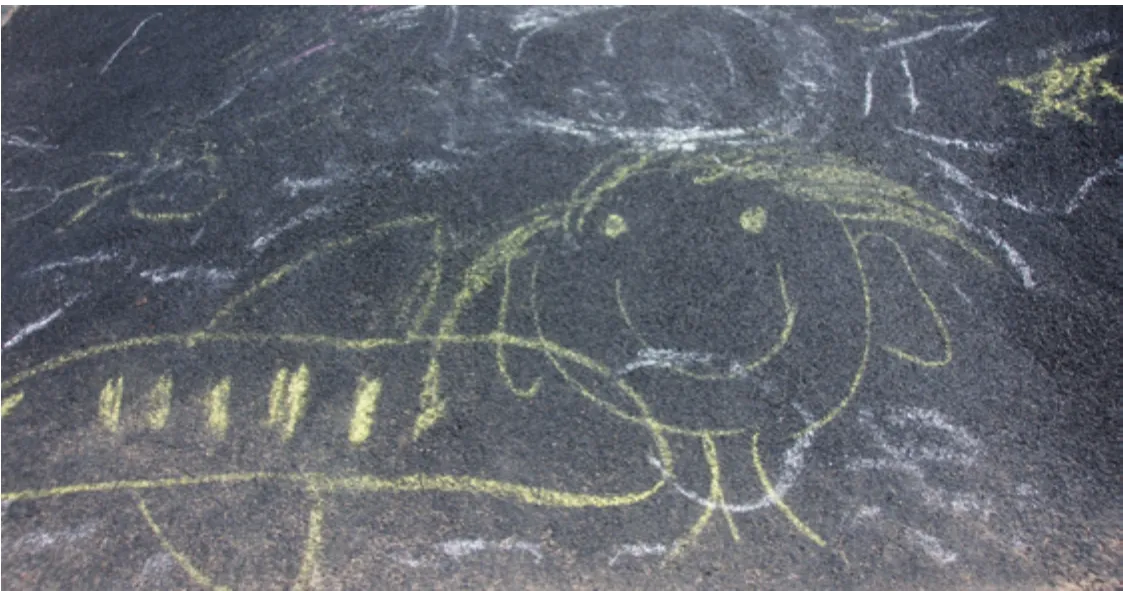
8 Carve 作品:Potgieter 街,荷兰阿姆斯特丹Carve's project , Potgieter,Amsterdam, Netherlands
于我,阿尔多的例子说明游乐场的意义在于其对社会的贡献以及它为特定场所带来的附加值。游乐场可以是更多可能性的起点。
LAJ:在设计中,您是如何平衡安全保障和探索乐趣的呢?
Elger:(笑)每个人都会问我游乐场的安全问题。首先,按照最新安全标准设计的,并拥有缓冲功能铺装的,且没有交通穿行的游乐场已经是相当安全的地方了。在人行道上走比在游乐场玩危险多了。但安全的游乐场并不意味着你完全不会受伤。
游乐场是儿童学习如何识别风险并与之相处的地方,他们在此学会为未来生活中的类似危险做好准备。他们通过跑、跳、攀登、预估、合作等来学习,并锻炼他们的认知和运动技能。我们的祖先在丛林里或大山中掌握了这些技能,今天的孩子们需要通过在游乐场中玩耍,应对小挑战来习得这一切。统计数据表明,如今被过度保护的儿童对风险的评估和应对能力不如以前的孩子们,那么他们长大成人以后也很难对风险进行有效判断。
总而言之,游戏伴随着程度可控的冒险,并不是一点伤害也没有。好的游乐场设计,应该鼓励孩子们尝试冒险,并且风险不应超过孩子们的身体机能可以控制的范围。
我们所有的作品都符合欧洲或者其他地区的高级安全标准,但是你要知道游乐场并不能阻止人们故意闯祸(例如从10m高的地方跳下来)。仅仅符合标准并不等于安全,我很容易就能想到一些符合标准但是一点都不安全的设计。安全还需要人们有常识。另外,还有一点非常重要,有些安全并没有被写进标准。举一个相当有荷兰特色的例子:在荷兰,绝大多数开放水域都是没有栅栏的。这在某些国家和地区可能是无法想象的。这是因为几乎所有的荷兰小孩三岁就学习游泳了。
LAJ:您认为体感游戏、虚拟现实之类的技术对户外游戏有冲击吗?
Elger:虚拟现实和电子游戏让成年人担心他们的小孩不出门。同时,他们也因为工作太忙把孩子丢在屋里,不去花时间陪小孩。
孩子们很少感到无聊。他们保持开放,即使最简单的东西也会引起他们的好奇和惊讶。我还记得我和我的孩子们在没有网络的森林小屋里相处。他们确实有抱怨无聊,但当他们走到户外就不一样了,他们捡树枝,捡石头,搭小房子,跳过小水洼,等等。我相信虚拟现实和户外游戏是完全不同的东西,它们并不冲突(图14、15)。
LAJ:在过去的20年里,您觉得游乐场设计这个领域有没有什么变化呢?
Elger:我想你这样问是因为我们已经有20年的历史了。和最初相比,我们现在受到了更认真的对待。我们刚开始的时候几乎没法靠设计游乐场存活。2006年,我们的作品Wall-holla取得了巨大的成功。这是我们在游乐场设计上取得的里程碑性突破(图16、17)。
也正是在那个时候,人们对于“玩”的看法发生了改变,玩被认为是生活中不可或缺的价值。很多东西一下子就成了“游乐场”,或者“像游乐场一样的”。我们很高兴我们早在十年前(1997年)就介入了这个行业,积累了很多经验。
不过,“玩”本身并没有什么变化。这对不同文化背景的孩子来说都差不多,这也是为什么“玩”如此有趣和迷人。
(除特别注明来源外,本文所有图片版权归荷兰卡韦事务所所有)
LAJ: Could you please show me a recent project from Carve?
Elger: One of our more recent projects is Be-Mine, a former coalmine in Belgium. Part of the project was the playful access of the slag hill that is almost 65 meters high.
Our proposal is based on using the true section and surface of this hillock as the actual playing surface.The design was influenced both by the hardship and the comradeship that the former mineworkers encountered. You can climb up in numerous ways either solely or with the help of your friends (Fig. 1,2).
This project was a collaboration with Omgeving a local landscape firm and Krinkels a Belgian contractor. Due to the height of over 60 meters there where of course many concerns and discussion about children's safety. Luckily all our projects are and have to be certified by independent safety institutes that proved that the total installation including the super long slide where within all safety standards.
LAJ: How did you started Carve 20 years ago?
Elger: Coincidentally I should say, I studied architecture, and had been involved in skateboarding since the beginning of the eighties when I was still in secondary school.
Due to the lack of any skate parks in the public realm at that time we started designing and building our own skate parks. Beginning of the nineties I successfully assisted a playground company developing skate facilities, that lead into a job offer to design their play equipment and street furniture as well (Fig. 3).
During my employment I started being more interested in what "play" could mean from a perspective of urbanity then being interested in play equipment as a standalone feature. To bring my ideas into practice I had to start my own design agency.
LAJ: At what were you unsatisfied at that time?
Elger: Mid nineties of the last century playgrounds where more or less a loosely scattered amount of equipment selected from a brochure. I was not satisfied with several aspects, for instance you would never find the same quality and magic as you did find on that mogul field that used to be behind your house when you were young, but I was also disappointed with the quality of the design of the equipment itself. Why not have specially designed site specific playgrounds and equipment in the same way that you would hire an architect that designs a building? I was fascinated by the idea to bring that architectural quality to the playgrounds that we were working on.
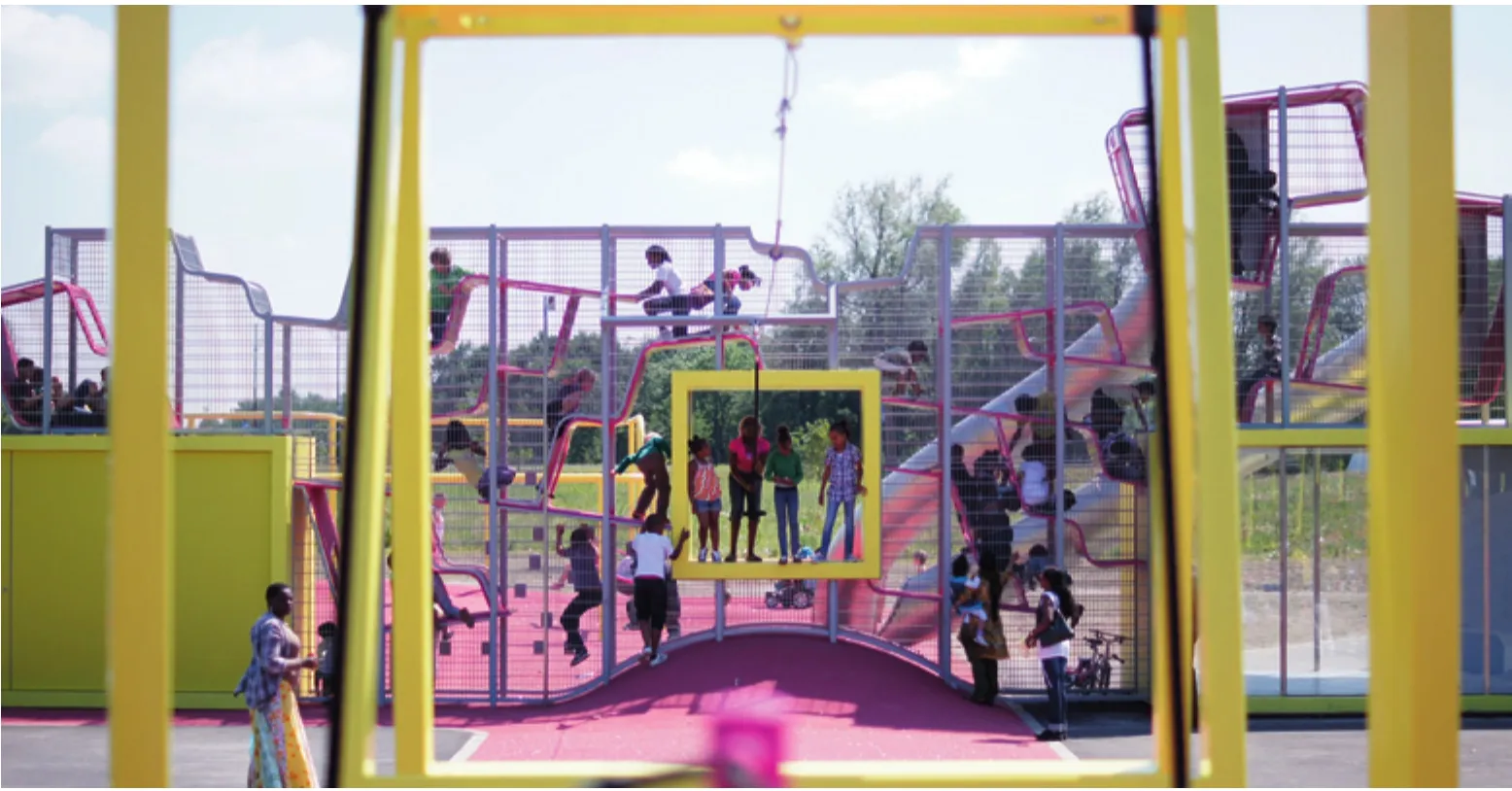
9 Carve 作品:Bijlmer 公园,荷兰阿姆斯特丹Carve,s project , Bijlmer,Amsterdam, Netherlands
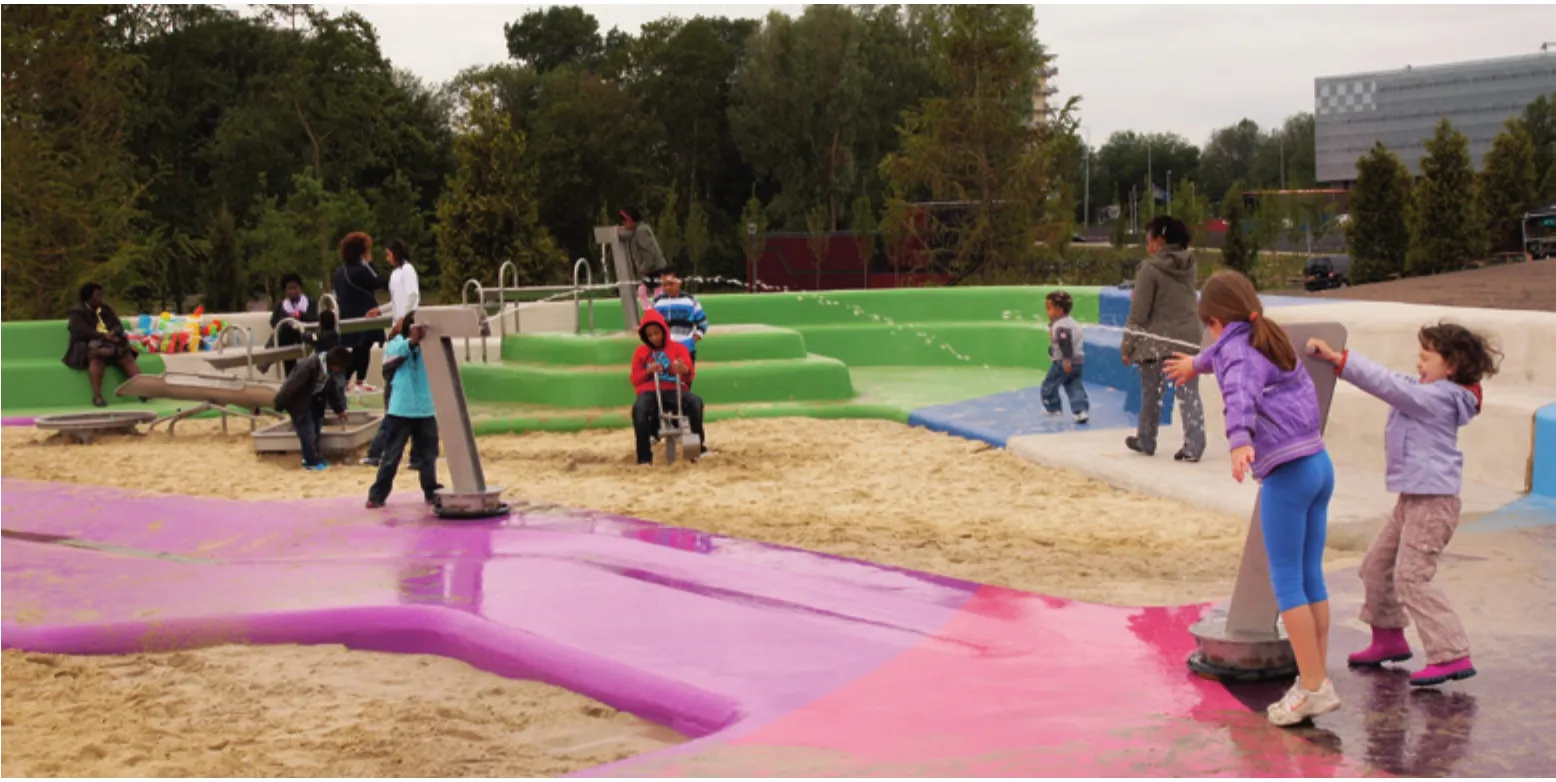
10 Carve 作品:Bijlmer 公园,荷兰阿姆斯特丹Carve,s project , Bijlmer,Amsterdam, Netherlands
LAJ: What do you mean by 'architectural quality'?
Elger: With architectural quality I mean the enhanced quality that comes with good design, or good architecture in general. Nothing worse then a standard "condo" from the building contractors catalogue, seen from the perspective of the architect, why couldn't this be the same for playgrounds they could be designed both around specific needs, reflecting or fitting site specifics and could be bespoke, instead of just being selected from a brochure giving you the choice between a red steel or blue steel swing. I find it rather peculiar that a playground these days either in Amsterdam, Beijing or New York would look practically the same, coming from a certain "Scandinavian"supplier. If it wasn't for the surroundings you wouldn't even know where the playground was situated. And consider it from a child's perspective as well: "let's meet at the playground with the plastic slide" that could be anywhere or would you rather say let's meet at the "blue hill square"? Its all about sense of place(Fig.4~6).
LAJ: All your works are unique. Does it mean that they are expensive?
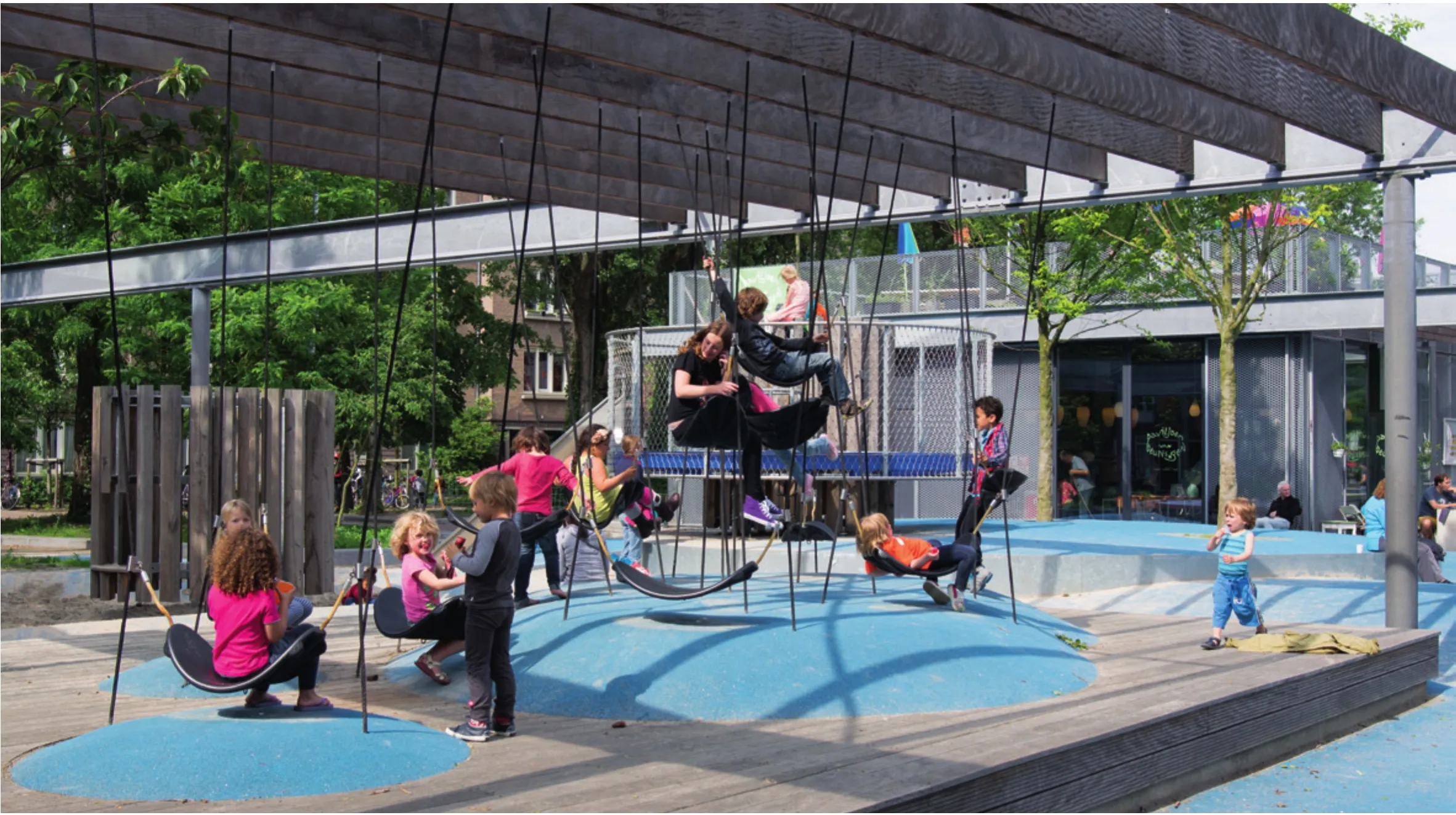
11 Carve作品:Van beuningenplein,荷兰阿姆斯特丹Carve's project , Van beuningenplein,Amsterdam, Netherlands
Elger: It is not for me to judge if all our designs are unique, at least we try to. Regarding budgets you would be surprised to learn that a specially designed playground is usually not more expensive then a "from the shelf" equipped playground. Production, wholesale, agents etc. they all want their share. You could compare this to any consumer product that due to the supply chain has marked up 3 to 4 times; a pair of Brand sneakers, would be sold for 100 dollars but the fabrication is only 25! With todays modern fabrication techniques, like 3d printing and cutting, is has also become more easy and economically more affordable to make one time only large scale "strange" objects. We use these techniques quite often. The only thing I can think of as a disadvantage in the way we work is the fact that the design process takes time, compared to ordering brochure equipment. But for sure the outcome ofour projects would easily pay up for that.
LAJ: Most of your works are colorful. What ideas are behind colors?
Elger:Colors are not by far that important to me as other aspects of our designs, very often colorful playgrounds are only waving to adults "look this is a playground". We have even made complete black playgrounds(Fig. 7,8). They are as attractive to children as the colorful, most interestingly the children started using the black safety surfacing as a chalkboard, something that we could never had thought of, and a fine illustration of the interpretation that children have their own dedicated play area's.
Of course we have also made extreme colored playgrounds, for instance in "Bijlmerpark" color was the leading motif here after we had attended several participative meetings. Bright colors where the binding factor in this neighborhood where a major part of the population is from different ethnic backgrounds(Fig. 9,10).
Another example is the blue we used for the Van Beuningenplein, the adjacent buildings are one of the very few social housing that were designed by K.P.C the Bazel, a famous 19th century architect that was also known for its pressed glass blue tableware. That's exactly how arbitrary color choices are(Fig. 11,12).
LAJ: It's ture. Aldo van Eyck's playgrounds are colorless (Fig. 13).
Elger: That is absolutely true, and that also demonstrates why the relevance of play is not in the color.
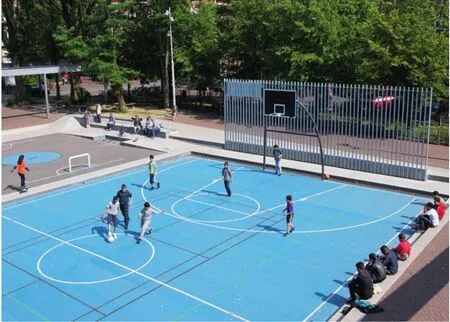
12 Carve作品:Van beuningenplein,荷兰阿姆斯特丹Carve's project , Van beuningenplein,Amsterdam, Netherlands
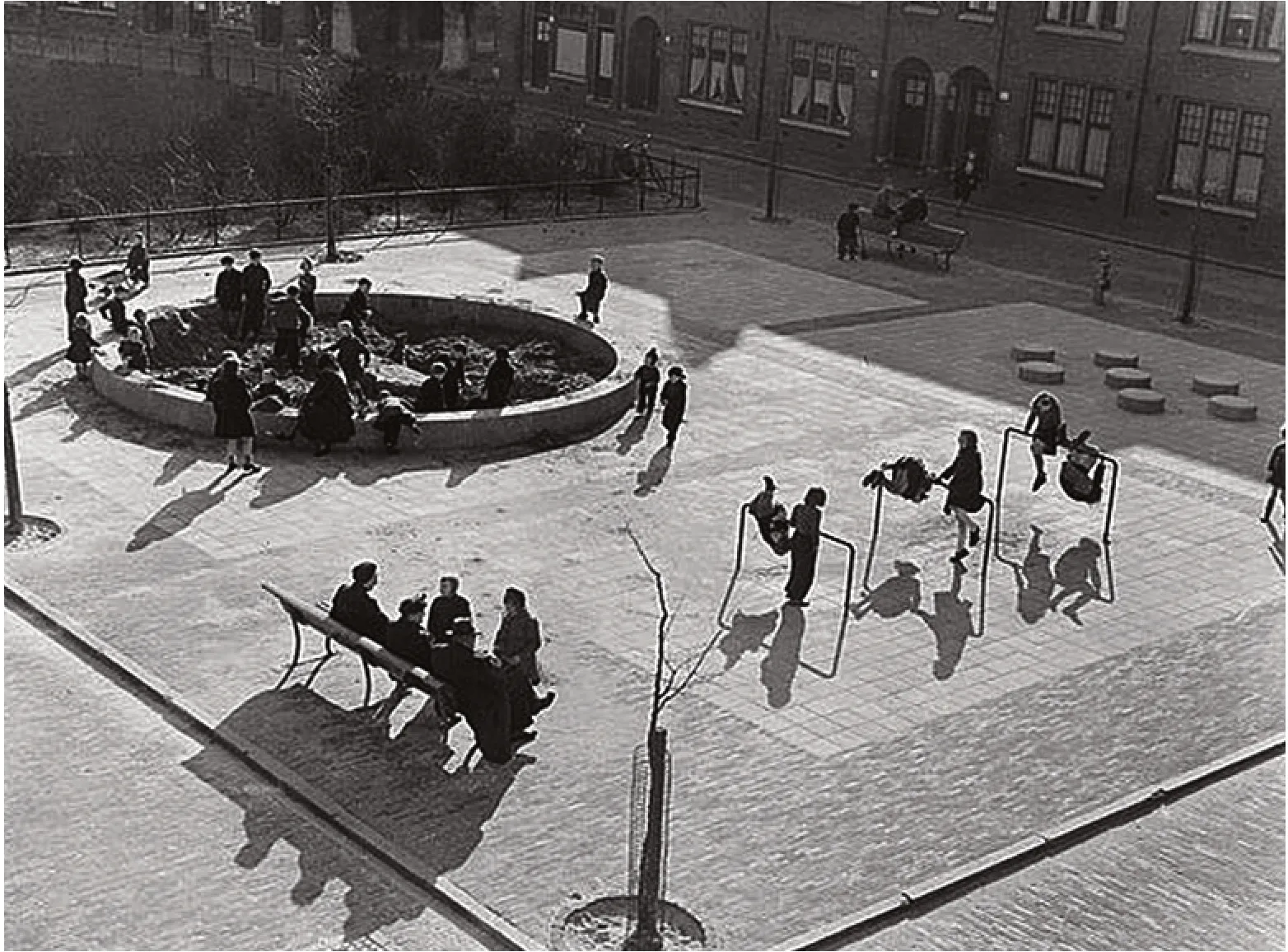
13 Aldo van Eyck在阿姆斯特丹的游乐场项目之一One of Aldo van Eyck's playgrounds in Amsterdam, Netherlands
In general people speak about Aldo's 700 and over playgrounds, but the importance of Aldo's playgrounds, for me, is what he has contributedwith them to society.
The modernist layout of Amsterdam as designed by Van Eesteren before the Second World War was imaginably not going to be a place that was relating to the human scale let alone "children's" scale.
Aldo van Eyck (and Jacoba Mulder) "softened" Van Eesteren's urban planning by introducing L-shaped building blocks thus creating some sort of public inner courts open for everyone and free of cars. He situated simple play equipment in these places that attracted children at first, parents followed. A well thought strategy for stimulating social connections.
Aldo represents for me the idea that the importance is all about the contribution and added value you can bring to a certain place and where the playground can be the start of something more.
LAJ: How do you balance the security and the joy of exploration in your design?
Elger: (Laughs) Everybody is always asking about safety on playgrounds. Firstly todays playgrounds are already extremely safe places, build to the latest standards, no traffic and lushly covered with a impact attenuating floor. Walking on the adjacent sidewalk is much more dangerous then the playground. But having said so a safe playground doesn't mean that you can't get injured at all.
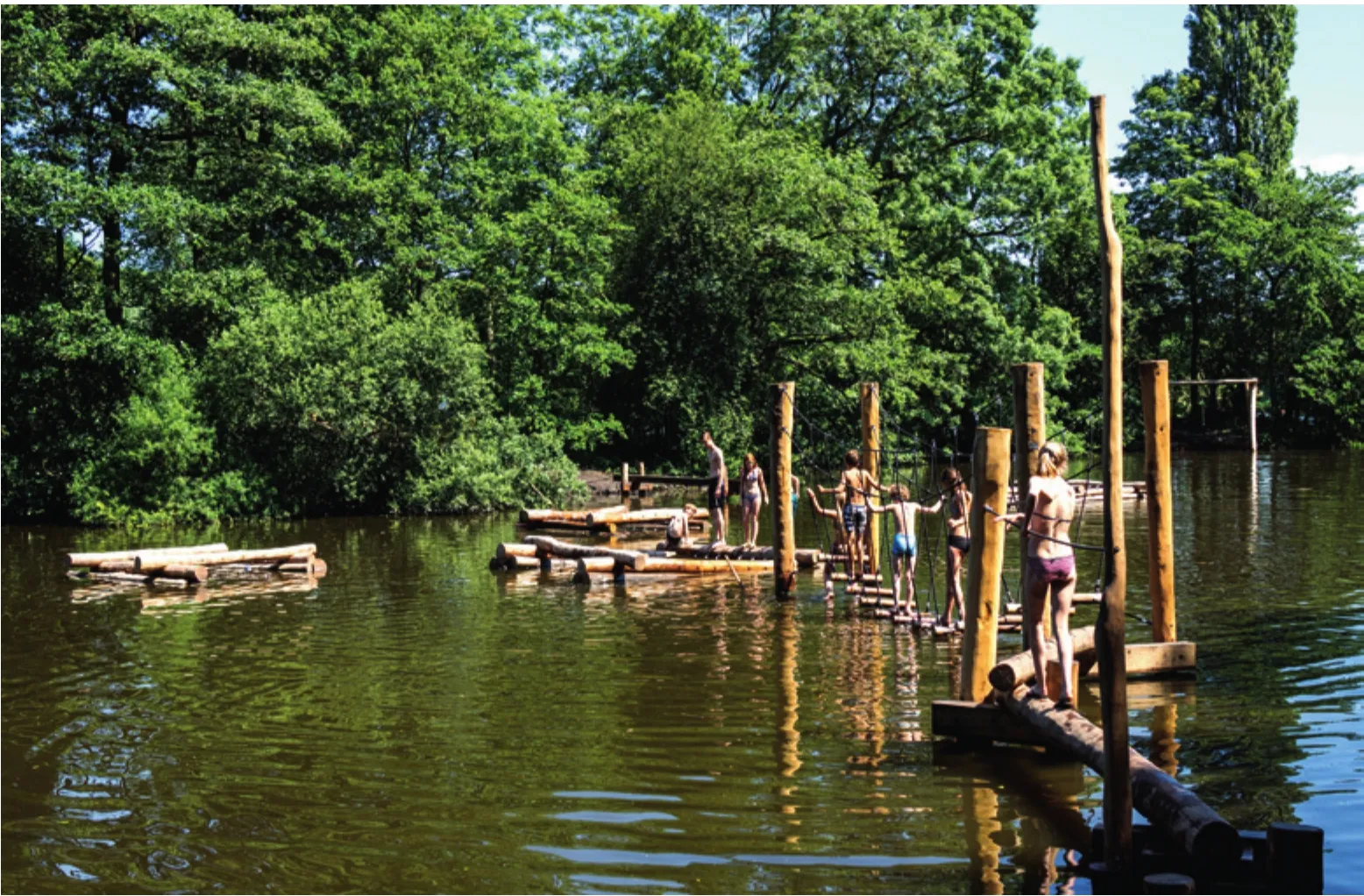
14 Carve 作品:游戏岛,阿姆斯特丹森林公园Carve's project , play island,Amsterdam, Netherlands
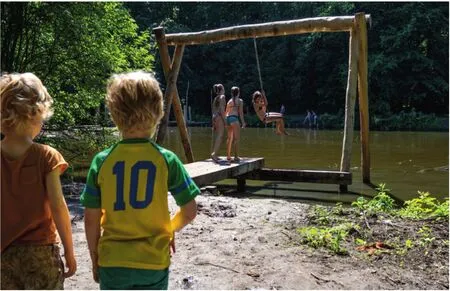
15 Carve 作品:游戏岛,阿姆斯特丹森林公园Carve's project , play island,Amsterdam, Netherlands
Playgrounds are safe environments where children learn to cope with risks, learn how to avoid and/or handle potential risks hence being educated to "prepare" themselves for similar dangers they could encounter in future life. This is done by jumping, scaling, running, estimating, cooperating and so on, they are training their motor and cognitive skills. As our ancestors did in forests ormountainsides. In todays life children need to learn this through playing on a playground. They have to practice and learn this by being challenged to take calculable risks. Statistics have showed that today's children are not capable as well as children from other generations to calculate and deal with these risks anymore by being over protected, hence not being able to judge risks as well by the time they are adults.
To conclude playing comes with a acceptable hazard and is not injury free. A good playground is build in a way that both stimulates taking risks but limits these risks to an acceptable level for children in relation to their motor and cognitive skills.
All of our projects always meet the European or any other standard that is prevailing locally around the world. One shouldn't forget though that playgrounds cannot eliminate risks deliberately taken (like jumping from a 10 meter high cliff). Safety is not in the standard itself, I can easily think of designs that would perfectly match the safety standard but aren't safe at all, safety is also about common sense. Last but not least there is also safety that is not written in standards. Let me give you a very "Dutch" example, most open water in the Netherlands is not fenced off, something unthinkable in many countries; but all Dutch children learn to swim starting as young as three years old.
LAJ: Do you thin technologies, such as virutal reality, have impact on outdoor playing?
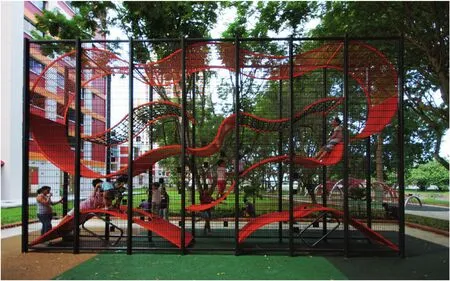
16 Wall-holla(新加坡)为Carve在2006年设计的垂直游戏装置,获当年荷兰设计奖。该作品受到了世界各地的广泛欢迎。Carve vertical game device designed by Wall -holla(Singapore)in 2006, which won the Dutch design awards that year. The work was popular all over the world.
Elger: Virtual reality and digital gaming are things that worry parents, being afraid that their offspring stays inside. But it's the same parents that keep the children inside being too busy with working etc. and not having the time to accompanytheir children.
Children are seldom bored and are always open to be astounded and amazed by the simplest of things. I remember staying with my kids in a forest lodge, no wifi available. And yes they complained pretended to be bored, but rapidly interchange this, ones collecting sprigs stones, building huts, jumping puddles etc outdoors. I have a strong believe that both VR, digital gaming and outdoor or physically intense playing are complete different things, both having existence next to each other(Fig.14,15).
LAJ: Is there any change in this field during the past 20 years?
Elger: I think you are comparing to the fact that Carve exists 20 years. Compared to then we are taken much more seriously. When we had just started we could hardly survive by only designing play-environments. Around 2006 one of our play installations, "The wallholla" became a big success overnight. It was both a breakthrough for us as for the design of play equipment(Fig.16,17).
Around the same that there was also a change in thinking about "play". It started to be seen as a value in life and a parameter in everything, suddenly everything was called a playground or reflected upon as ''playgroundlike''. We were happy to have started our agency ten years before, and where appreciated to have a certain kind of expertise in that particular field.
Playing in general.......hasn't changed, nor is it substantially different between children of different cultures, and that is exactly what it makes it so interesting and intriguing.
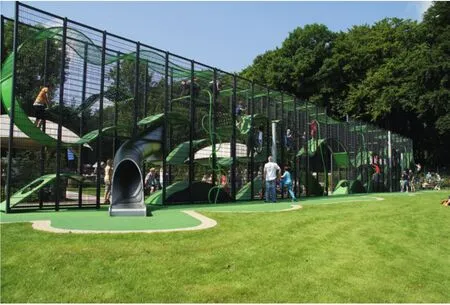
17 Wall-holla(德国)为Carve在2006年设计的垂直游戏装置,获当年荷兰设计奖。该作品受到了世界各地的广泛欢迎。Carve vertical game device designed by Wall -holla(Germany)in 2006, which won the Dutch designawards that year. The work was popular all over the world.
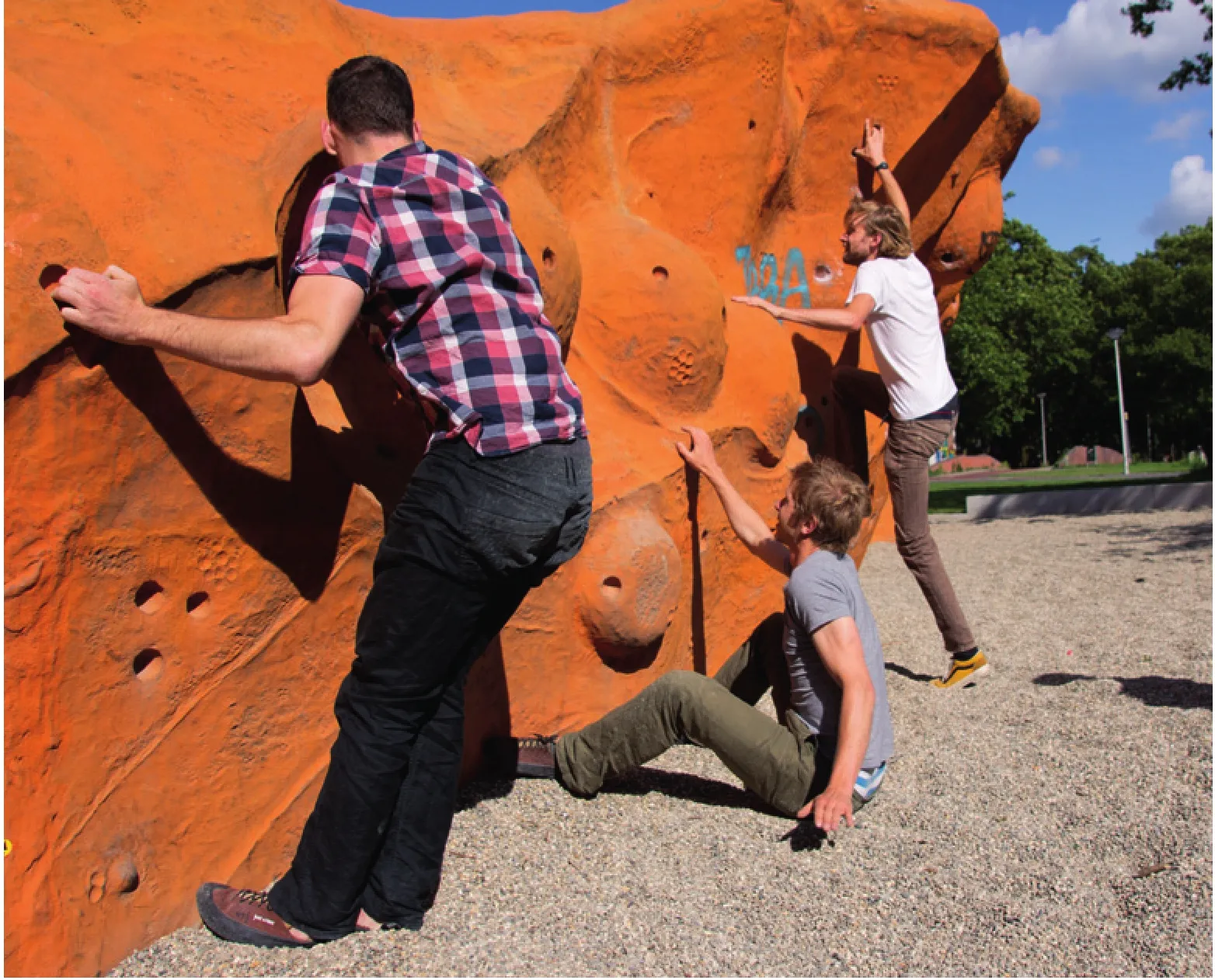
18 Carve的设计师在他们设计的游乐场The designers of Carve were playing in the playground designed by themselves
